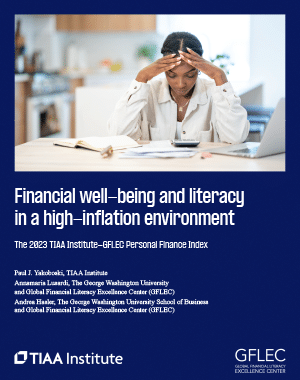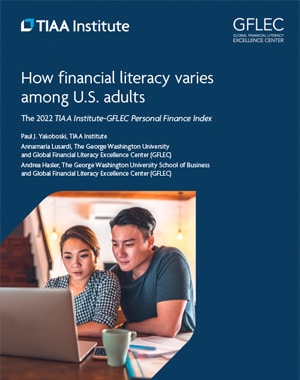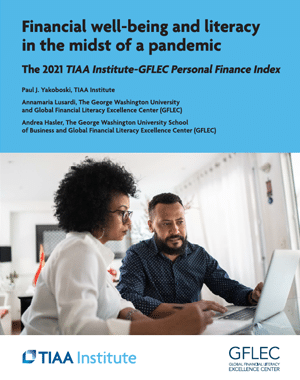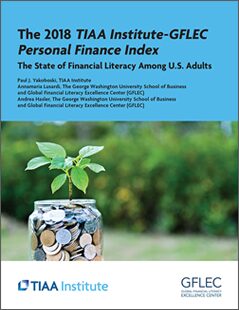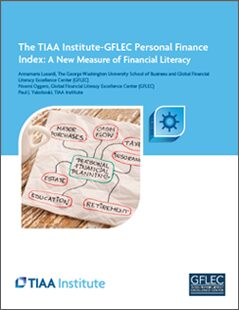The TIAA Institute-GFLEC Personal Finance Index (P-Fin Index) measures knowledge and understanding that enable sound financial decision making and effective management of personal finances among U.S. adults. The P-Fin Index is an annual survey developed by the TIAA Institute and the Global Financial Literacy Excellence Center, in consultation with Greenwald & Associates. It is unique in its breadth of questions and its coverage of the topics that measure financial literacy. The index is based on responses to 28 questions across eight functional areas: earning, consuming, saving, investing, borrowing/managing debt, insuring, comprehending risk, and go-to information sources.


FINANCIAL LITERACY AND RETIREMENT FLUENCY
New insights for improving financial well-being
Highlights from the 2024 P-Fin Index
- Financial literacy among women has consistently lagged that of men. There is a 10-point gender gap in the percentage of index questions correctly answered in 2024.
- Financial literacy levels among Asian and White Americans are roughly equal. Likewise, financial literacy levels among Black and Hispanic Americans are roughly equal, albeit at lower levels.
- Financial literacy tends to be low across generations, but particularly so among Generation Z—on average, Gen Z correctly answered only 37% of the index questions in 2024.
- Functional knowledge is substantially lower among Gen Z compared with Generation Y, Generation X, and baby boomers in all eight areas examined. Comprehending risk is the area with the least generational variation in functional knowledge; even older adults with more experience in financial decision-making score low on risk-related questions.
- Analogous to overall financial literacy, functional knowledge levels among women tend to lag those of men, and the gap is statistically significant across all functional areas.
- Compared with those with a very high level of financial literacy, those with a very low level are twice as likely to be debt-constrained; three and one-half times more likely to be financially fragile; four times more likely to lack one month of emergency savings; three times more likely to be not at all confident in their retirement income prospects; and three times more likely to spend 10-plus hours per week on personal finance issues.
- Twenty-six percent of those who correctly answered 4 or 5 of the retirement fluency questions are very confident they will have enough money to live comfortably throughout retirement, while only 7% are not at all confident. These figures are essentially flipped among those who didn’t correctly answer any of the questions (29% and 10%, respectively).
 The consistently low levels of financial literacy among U.S. adults, particularly among the most vulnerable groups, is troubling. These findings are a call to action. It is high time to change the conversation about money, starting with adding financial education in school and college.
The consistently low levels of financial literacy among U.S. adults, particularly among the most vulnerable groups, is troubling. These findings are a call to action. It is high time to change the conversation about money, starting with adding financial education in school and college.
— Annamaria Lusardi
Information about the survey
The initial wave of the survey was fielded online in September 2016 to a nationally representative sample of U.S. adults, ages 18 and older. Each year, the survey oversamples a particular demographic group to better understand the financial literacy levels and financial behaviors of that group. Because the P-Fin Index is an annual study, future waves will enable trend analysis of overall personal finance knowledge, as well as knowledge in the different functional areas and across demographic groups.
P-Fin Index Research

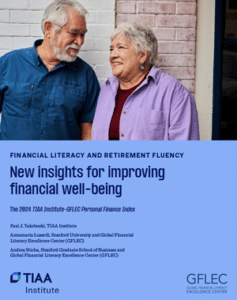 2024
2024